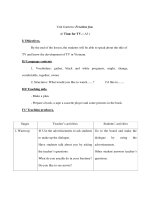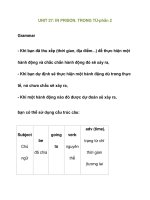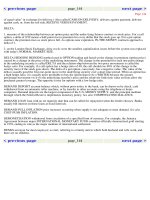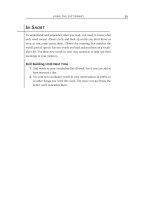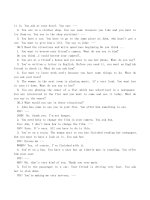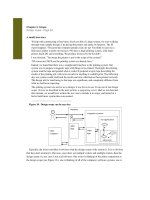Writing Skills in Practice health professionals phần 3 potx
Bạn đang xem bản rút gọn của tài liệu. Xem và tải ngay bản đầy đủ của tài liệu tại đây (274.44 KB, 31 trang )
69 RECORD KEEPING
Actions
Record
Keep on file
Referral/first
contact
* Set up personal health
record
* Client identification details
* Reason for and date of referral or attendance
* Name and position of the referrer
* Referral form or letter/admission slip
* Accompanying reports
Initial
* Evaluate clinical need
* A case history
* Case history form or admission sheet
assessment
* Client’s views about the problem
* Clinical observations
* Tests, investigations and procedures
* Interpretation
* Diagnosis/prognosis
* Actions/recommendations
* Consent forms for specific
investigations
* Forms or charts used in tests,
investigations or procedures
* Communication about
assessment
* Client’s concerns and views on the assessment
and outcome
* A copy of reports or letters circulated
about the assessment
* Refer on as appropriate
* Copies of referral letters to other
professionals
Intervention
* Set careplan
* Record objectives
* Consent forms for treatment, therapy
* Record client’s views about careplan
or surgery
* Careplan
Figure 4.1: Summary of record keeping at key stages in the care process
70 WRITING SKILLS IN PRACTICE
Actions
Record
Keep on file
* Implement careplan
* Evaluate careplan
* Record interventions
* Record client’s responses
* Record outcomes
* Record clinical decision making
* Progress records
Discharge
* Re-evaluation of clinical
need
* Preparation for
discharge
* Discharge
* Communication of
closure intentions
* Results of investigations, tests or procedures
* Treatment outcomes
* Assessment of the client’s ability to manage
on-going care needs
* Liaison with other agencies
* Views of the client and client’s family or
significant others
* Advice/instructions to client and family/carers
* Date and reason for the discharge
* Name and status of the clinician who made
the decision
* Discussion with client/referrer/other
professionals about closure intentions
* Results of assessments relating to
discharge decision
* Copies of referrals to other services
* Copy of discharge instruction sheets
* Discharge report
Post-discharge
* Retention of records for
recommended minimum
period of time
* Complete administration procedures relating
to storage and future retrieval of records
* File record in secure storage
Figure 4.1 cont’d
5
Letters and Reports
Letters and reports about the care and management of clients are an essen
-
tial form of communication within the health service. This chapter reviews
how to plan, structure and present such correspondence.
Letters
There are two types of letter – formal and informal. The two are distin-
guished from each other by different styles, presentation and tone.
Formal letters refer to correspondence that has an official or business
function. They are printed or typed on headed paper using a conventional
style of composition. The manner of address is formal rather than personal,
so the preferred title and last name of the recipient is used to start the letter.
They are signed off with the name, position, title and qualifications of the
letter writer.
Informal letters are written using a more conversational tone and are
sent between two people who know each other. The usual form of address
in these letters is by the first name.
Letters are only one of the means of communication available to the
health professional; however, they have certain advantages over other
methods.
Choose a letter if you want to:
°
present complex information and elaborate on ideas
°
have time to organise your thoughts and review your
intended message
°
have a confidential means to convey information
71
72 WRITING SKILLS IN PRACTICE
°
indicate to the recipient the seriousness of the matter under
discussion.
Sometimes a letter is not always the most appropriate or most sensitive
choice of communication.
If your message: Consider using:
is urgent e-mail,
fax,
telephone
is an apology telephone,
face-to-face contact
requires explanation face-to-face contact,
telephone
is informal, brief or a reminder e-mail,
memo
requires discussion or exchange meeting,
of ideas or involves decision making video or telephone
conferencing.
Structure of letters
Letters consist of:
°
a greeting
°
an introduction
°
the main body
°
the conclusion
°
a closing sentence
°
a signature.
Greetings
The way in which you address the recipient will depend on whether you
are writing a formal or informal letter. In certain circumstances a more gen
-
eral term like ‘client’ or ‘parent’ may be permissible in letters sent en masse
or if you are unable to verify the recipient’s name.
Introduction
The first paragraph will state clearly the reason or purpose for writing.
73 LETTERS AND REPORTS
The following examples show how the use of some pertinent details
(including the date) helps the writer indicate the topic or subject of the
message to the reader.
In response to a letter or other type of contact – ‘Thank you for your
letter dated … regarding …’ or ‘Thank you for your phone call on the … I
am sorry I was not available to speak to you personally’; ‘I am writing to
you regarding your enquiry on the … about the waiting list for day sur
-
gery.’
To make an enquiry – ‘I am writing to you regarding the shortage of
car parking at Ginsbury Health Centre. I would like to find out whether it
would be possible to install a barrier that will restrict access to staff mem
-
bers.’
Some letters start using a traditional format. For example, referral let
-
ters usually start with a sentence like: ‘Thank you for seeing this elderly gen
-
tleman who has been complaining of chest pains for the last three days.’
The main body
This contains the main message of the letter along with any supporting de-
tails or information.
Conclusion
The content of the conclusion will vary according to the purpose of the
letter. It may include a summary, recommendations, request for action or a
statement of what is expected from the recipient.
Closing sentence
A letter is usually brought to an end by the use of a closing sentence. For
example, ‘I look forward to hearing from you’, ‘Please do not hesitate to
contact me if you need further information’ or ‘Thank you for your assis
-
tance in this matter.’ The addition of phrases such as ‘best wishes’ or ‘kind
regards’ helps to add a courteous note, particularly in informal letters.
Signature
Letters must always be signed, as they may be required as evidence in the
event of a complaint or litigation. The signature shows that the health pro
-
fessional, or another person authorised to do so in his or her absence, has
checked the letter and agreed the content. Formal letters require the signa
-
74 WRITING SKILLS IN PRACTICE
ture to be accompanied by the title, position and in some cases the qualifi
-
cations of the letter writer.
The subscription accompanying the signature will depend on the form
of address used in the greeting. A letter starting with ‘Dear Sir/Madam’
will end with ‘Yours faithfully’, whereas one starting with the first name,
or title and last name, will end with ‘Yours sincerely’.
Layout and format of a letter
Letters are set out according to a standard format. Figure 5.1 is an example
of a standard layout.
Remember:
°
Keep text well spaced with the left-hand margin aligned with
the start of the recipient’s address.
°
The current style is to have ‘open punctuation’ (Dobson
1995), where punctuation is kept to a minimum, so avoid
using full stops and commas in headings, addresses and dates
unless the clarity or meaning is affected by leaving them out.
°
Any special messages, like marking the letter ‘confidential’ or
for the attention of a specific person, also need to be marked
on the outside of the envelope.
°
It is not necessary to repeat headings on any continuation
sheets; however, they should be numbered. Mark the bottom
of the preceding page with ‘cont.’.
°
Use ‘date as postmark’ for large numbers of letters sent out at
routine intervals.
°
Include identification information on any tear-off slips.
Include the name and address of where to return the slip,
what it refers to (for example ‘diabetes clinic’) and any client
identification information.
75 LETTERS AND REPORTS
Heading
(usually the logo of the organisation)
Address
(if not included in
heading)
(check position for window envelopes)
Name and address of recipient
(write on separate lines)
(note this starts lower
down the page than
sender’s address)
Date dictated:
Date typed:
Our ref: (initials of sender/typist/file number)
Your ref: (any reference provided in previous correspondence
from addressee)
(align left-hand margin
with start of address)
Figure 5.1 Standard format of a letter
76 WRITING SKILLS IN PRACTICE
Dear…
Heading
(subject matter or name, DOB, address of client)
Introduction
Main body
Conclusion
Closing phrase
Yours sincerely/faithfully,
(note the use of a small ‘s’ and ‘f ’)
Space for signature
Name in full
(plus preferred form of address/
Position
title, qualifications)
(shows the recipient who else has seen
the letter/informs the secretary of the
circulation list)
Cc (names of people who will receive a copy)
Enc. (detail any enclosures, e.g. maps, timetable)
Figure 5.1 cont’d
77 LETTERS AND REPORTS
Writing a letter
You may be about to write your first clinical letter, either during your clini
-
cal practice or as part of an assignment for college. The following section
offers some guidance on the four stages in composing such a letter. They
are:
1. Preparation
2. Planning
3. Drafting
4. Editing.
1. Preparation
(a) Decide on your terms of reference
What is your reason for writing the letter? Who is the most appropriate
person to receive the letter? What is your timeframe? Who needs a copy of
the letter?
An additional question to consider is whether you are the most appro-
priate person to write the letter. This is essential where situations are liti-
gious. In these cases you may need to refer to a senior colleague or manager
before proceeding.
(b) Gather your facts
Before starting the letter you need to make sure that you have all the rele
-
vant facts and figures. It is important to be accurate and to verify any infor
-
mation. Mistakes in a letter between clinicians may lead to
misunderstandings or delays in the assessment and treatment of a client.
Remember that your letter, like any other part of a health record, may be
used as evidence in a court of law. Any mistakes are likely to reduce your
credibility as a competent witness or defendant.
2. Planning
You can start to plan your letter once you have established your terms of
reference and gathered the necessary information. You will need to select
information that is relevant for both the purpose of the letter and the needs
of the reader.
78 WRITING SKILLS IN PRACTICE
What is the purpose of your letter?
Think about why you are writing the letter. Is it:
°
to request information (for example information about
previous treatment)
°
to give information (for example test results)
°
to request action (for example making a referral)
°
to confirm an action has taken place (for example a discharge
summary)
°
to organise (for example making an appointment)
°
to respond (for example replying to a complaint)
°
to explain requirements (for example explaining procedures
for making referrals)?
Always consider your reader during the planning stage:
What does he or she know already?
°
This will help you to avoid any redundancy in your message.
What does he or she need to know from your letter?
°
This will help you in selecting relevant information and
making your message specific.
What are the reader’s expectations of the letter?
°
You will have your own ideas about what you want to
achieve. For example, you may judge your explanation of
events a successful response to a client’s complaint. However,
it may disappoint the client if his or her expectation was that
the letter would also include an outline of intended actions to
prevent future occurrences.
Finally, decide on the logical sequence for presenting the information. Ar
-
range the data in the appropriate order using bullet points. This will form
the basic plan for your letter.
3. Drafting your letter
Write your letter for your reader:
°
Choose your words with care. Avoid unnecessary technical
terms or abbreviations, especially when writing to clients.
79 LETTERS AND REPORTS
°
Keep your sentences and vocabulary simple and
straightforward.
°
Be specific. For example, rather than using ‘as soon as
possible’, give an exact date.
°
Write in a tone that suits the reader and the purpose of the
letter, for example using personal pronouns in response to a
complaint.
°
Avoid rhetorical questions. As they only have one answer, it
may look as if you are trying to lead the reader to a specific
conclusion.
°
Keep statements positive and direct wherever possible.
4. Editing your draft
Once you have written your draft, you can check the content, spelling,
grammar and presentation.
Use the following checklist to help you make your edits:
q
Is it accurate?
q
Is it logical?
q
Is the information organised coherently?
q
Is it clear?
q
Have you addressed all the issues?
q
Does it have a natural flow?
q
Does it appear too brief?
(Check you have included all the relevant details or information
to support your message.)
q
Does it appear overlong?
(Remove any irrelevant material or repetitions. Try to re-phrase
to make it more concise. If it is still too long, you may need to
write a report or call a meeting instead.)
q
Are the spelling and grammar correct? (Remember that using a
computer’s spellchecker is not a foolproof method.)
Once you have finished your edit you are ready to complete your final
draft. Do one final proofread. This is particularly important if someone
else has typed your letter.
80 WRITING SKILLS IN PRACTICE
Remember to ensure that copies of your letter go to other relevant pro
-
fessionals or agencies. Keep a copy on file, particularly if it relates to a cli
-
ent.
Below are some examples of key content for common types of letters.
Appointment letter – key content
°
Name, address and identification details (date of birth,
hospital number and so on) of the client.
°
Name of the clinician who will be seeing the client. (Indicate
if the client may be seen by someone other than the named
professional in the letter, for example, ‘Mr R Johns or a
member of his team’.)
°
Name of the department offering the appointment.
°
Address and telephone number of the clinic that the client
will be attending.
°
Day, date and time of appointment.
°
Any instructions about preparation for the appointment. (For
example, bringing a parent-held record to a baby clinic,
completing a registration form, or bringing a urine sample.)
°
Directions about the location of the clinic and procedures, for
example, ‘Book in with reception on level 2, North Wing’.
°
Instructions regarding the appointment itself such as the
presence of medical students.
°
Details of any relevant policies, for example on
non-attendance or late arrival.
°
Information on how to change the appointment.
°
Name, contact address and telephone number of the letter
writer.
°
Position and signature of the letter writer.
Common mistakes in appointment letters
Inaccurate or out of date client address means delayed or misdirected post
and appointments may be missed.
Letters where the clinic address differs from that given on the headed
paper are often confusing for the client.
81 LETTERS AND REPORTS
Referral letter – key content
°
Name, address and identification details (date of birth,
hospital number and so on) of the subject of the referral.
°
Date client seen by the referrer.
°
Brief details of the nature of the referrer’s contact with the
client.
°
Reason for the referral.
°
Brief description of relevant clinical details (presenting
symptoms, diagnosis, relevant past medical history, results of
assessments or investigations or summary of intervention).
°
Information on priority.
°
Information on other agencies involved with the client if
appropriate.
°
Other relevant details about the client, for example needs an
interpreter.
°
Name, contact address and telephone number of referrer.
°
Position and title of referrer.
°
Signature of referrer.
Common mistakes in referral letters
Letter fails to provide sufficient details to enable the receiver to prioritise
the referral.
Client contact details are incomplete or out of date so it is difficult to
notify the client about appointments.
Important information relating to the client is omitted, for example
the client requires an interpreter or hospital transport. This can lead to
missed appointments or unsatisfactory interviews.
Letter in reply to a complaint – key content
°
Name, address and identification details of complainant.
°
Reason why you are writing the response (for example
service manager, head of department).
°
Apology (even just to say ‘I am sorry to hear that you have
found our service unsatisfactory’).
82 WRITING SKILLS IN PRACTICE
°
Results of any investigations into the complaint.
°
Clear statements about whether the complaint is refuted or
accepted, supported by the following:
°
Re-iteration of any policy or guidelines in relation to the
complaint.
°
Completed actions in response to the complaint.
°
Intended actions in response to the complaint with a
timeframe for completion.
°
You may want to consider heading the letter ‘Without
prejudice’ in cases which have the potential to become
litigious.
°
Details on any further steps the complainant may take if still
dissatisfied.
°
Name, contact address and telephone number of letter writer.
°
Position and title of letter writer.
°
Signature.
Common mistakes in letters about complaints
The letter is written defensively – the clinician attempts to demonstrate his
or her expertise using jargon, technical terms and excessive clinical detail.
The letter introduces irrelevant information. For example, it is not ap-
propriate to include information about a lack of previous complaints about
a health worker or a service. The complainant will only find his or her own
experience of relevance.
Reports
Clinicians regularly write clinical reports about specific clients. These are
formal written accounts that are functional in nature rather than creative –
the writer being required to adhere to certain recognised practices in the
organisation and presentation of such material.
Format of reports
Reports have a basic structure consisting of:
°
a title
°
an introduction
83 LETTERS AND REPORTS
°
the main section
°
the conclusion
°
actions
°
recommendations.
Title
This tells the reader, at a glance, the subject matter of the report.
Introduction
The introduction in a report sets the scene for the reader, and makes clear
the purpose of the report. It will always include specific information about
where, when and why the report writer saw the client. A statement about
the source of the information can also be included at this point in the re
-
port, for example observations made during direct contacts with the client,
information from notes, discussion with the client’s family or liaison with
other professionals.
These details will help identify for the reader how and at what point
the report links in with the total care for that particular client. It is also use-
ful if the report is to be an accurate account for future reference.
In some circumstances it may be appropriate to give some background
information in the introduction, for instance a brief account of the nature
and length of the contact with the client. The emphasis is on brief, with
the main points expressed in no more than one or two sentences. A sub-
stantial description is better placed in a separate section under a heading
like ‘Background Information’ or ‘Other Relevant Information’.
Notes about any limitations on the scope or depth of a report are also
placed in the introduction (Inglis and Lewis 1982), for example if an as
-
sessment was incomplete due to the late arrival of the client.
Main section
Most of the information contained within a report is recorded within the
main section. The content usually relates to current actions, but may refer
to past or future events. It is therefore important to indicate the point in
time to which the information relates, for example, ‘in his previous assess
-
ment on …’.
84 WRITING SKILLS IN PRACTICE
Conclusion
This is a brief paragraph that summarises the main points of the report.
The conclusion to a report is often the hardest to write. It is not the place to
regurgitate lines from the main body of the text, nor should it contain any
new pieces of information. The writer must draw together the key mes
-
sages of the report and convey these as concisely as possible. The reader
will then be able to extract the key points and significant outcomes.
Actions and recommendations are usually listed at the end of the re
-
port.
Actions
The writer needs to make clear what actions he or she has taken or is plan
-
ning to take. They are most likely to be about:
°
arranging further investigations
°
referral to other services
°
initiating intervention
°
future management of the client (for example date when
client needs to be reviewed).
These need to be written in the form of specific statements that answer
questions like what, why, where, when and how?
Recommendations
Most reports contain advice by the report writer about the management of
the client. There will have been a logical development throughout the re
-
port that leads the reader to anticipate and understand this advice. Recom
-
mendations need to be presented clearly, so that they are easily identifiable
to the reader. It must be clear who is expected to carry out the action and
the expected timeframe. The use of a numbered list is often helpful.
Circulation list
One of the most useful aspects of a report is that by circulating copies, a
range of different people are informed. Copies are sent to the key profes
-
sionals or agencies involved with the client, for instance the client’s GP
would always receive a copy.
85 LETTERS AND REPORTS
Writing a report
You may be about to write your first clinical report, either during your clin
-
ical practice or as part of an assignment for college. The following section
offers some guidance on the four stages in constructing such a report. They
are:
1. Preparation
2. Planning
3. Drafting
4. Editing.
1. Preparation
Terms of reference
You may find that the timing, structure and scope of your report are to a
certain extent dictated by organisational guidelines. In some circumstances
there may be external factors influencing how you construct your report.
For instance, an expert witness report may have to follow a set format dic-
tated by the instructing solicitors.
Whatever the circumstances, you will still need to make certain deci-
sions before you start preparing your report. These will include deciding
on the:
°
purpose of the report
°
type of report
°
scope of the report
°
sources for gathering information for the report
°
timeframe
°
circulation list.
2. Planning
When planning your report you need to consider both its purpose and the
needs of its intended readers. This will help in selecting the most relevant
information and will determine the style and approach of the document.
86 WRITING SKILLS IN PRACTICE
What is the purpose of your report?
Think about why you are writing the report. The most common reasons
for writing a report are:
°
to inform (presenting facts and figures)
°
to influence (providing evidence that will persuade another
person to take a specific course of action)
°
to advise (offering recommendations)
°
to explain (presenting interpretations)
°
to record (documenting a contact)
°
to summarise (providing a synopsis of the main points).
What information does the reader require?
The first step in preparing a report, just like any other piece of writing, is to
consider the reader. What is his or her existing knowledge and experi-
ence? This will determine how much detail you need to include and how
you express your message. A comprehensive and relevant report will pro-
vide the reader with information that is both specific and in sufficient de-
tail to meet their needs.
Avoid giving too much detail, as it will be difficult for the reader to
identify the key messages. It is also likely that the report will not be read
thoroughly. However, too brief a report may mean the reader will need to
seek further information or, even worse, make a poor decision based on an
inadequate account of the facts.
Organisation
All reports, regardless of their length, need some sort of structure. The sec
-
tion above on the format of reports provides you with a basic framework.
This will help you select and organise information into a cohesive account.
You will need to decide on appropriate headings for subdividing the
content of the main body of your report. Breaking text into smaller sec
-
tions in this way assists the reader in assimilating large amounts of data.
The reader is also able to use headings to quickly locate specific details.
Another important consideration is the sequence in which you want
information to appear in a report. Without a logical order the reader would
be left struggling to work out the links between facts and figures.
There are various ways of ordering material, including:
87 LETTERS AND REPORTS
°
a temporal or chronological sequence (so past history would
come before the current examination and future actions
would come last)
°
a developmental sequence (so information about early play
would come before the development of spoken language)
°
a clinical sequence (so diagnosis would come before
information on intervention)
°
background information to specific information (so sections
about general information like education and living
accommodation would come before the more specific details
of an assessment).
Gather your facts
In the same way as you would prepare a letter, you need to gather all the
relevant facts and figures for your report. This information may come from
the results of investigations, progress notes in the personal health record or
explanations from the client. Thoroughness in record keeping will ensure
that the information you use is accurate, up to date and factual. These are
all requirements under the Data Protection Act (1998).
A brainstorming technique is often useful if you are dealing with a
large amount of information or if you need to address a difficult subject.
Write the central idea, theme or issue in the middle of a large sheet of pa-
per. Note down ideas, opinions, facts and figures associated with the cen-
tral idea using one- or two-word phrases. Join these to your keyword using
lines.
The effect is to create a visual spider’s web. Further details can be noted
around the ‘legs’ of the ‘spider’. Use lines and arrows to show how points
link together, and to indicate the hierarchy of the information.
Once you have covered all the areas, you can start to sort your data into
cohesive groupings. List key points under the relevant headings from your
report. Asking yourself questions is a useful way of focusing your thinking,
for example, ‘How do I know this child is showing a delay in gross motor
skills?’ This will help you select information that will help the reader to
come to the same conclusion – for example, that the child has delayed mo
-
tor skills.
88 WRITING SKILLS IN PRACTICE
3. Drafting your report
Once you have gathered your information and organised it into a basic
framework, you can start to prepare a draft. Writing a report is not just
about what you say but also how you say it.
Remember that the majority of reports will now be read by the client
and the client’s family or carers (NHS Plan 2001). Try to phrase your re
-
port in a way that is more accessible for a lay person with limited clinical or
technical knowledge. This is not to say that all terminology is to be ex
-
cluded. One idea to get around this problem is to provide a summary writ
-
ten specifically for the client (NHS Training Division 1994).
Remember that the way in which the message is expressed often inad
-
vertently conveys underlying attitudes. Look at this example: ‘Mother ini
-
tially denied any concerns about his hearing, but then confessed that she
thought he did have problems…’ These words imply some sort of negative
judgement on the part of the report writer about the client. Check that
your report is objective and your interpretations have a clear evidence base.
When preparing your final draft, consider how you will present the re-
port. Here are some general guidelines:
°
Place the name or logo of the employing organisation at the
top of the report.
°
Write a succinct title.
°
Place the contact address and telephone number of the report
writer in the top right-hand corner.
°
Mark all reports containing information about clients as
confidential. (Remember to mark this on the envelope as
well.)
°
Place the client’s name, address, date of birth and other
identification information like a hospital or social security
number in the top left-hand corner.
°
Date all reports. Indicate if there has been a delay between a
report being dictated or drafted, and the date when it was
actually typed. For instance:
°
Date dictated: 21/2/01
°
Date typed: 12/3/01.
89 LETTERS AND REPORTS
°
Always sign reports. Type or print your full name, title and
profession underneath your signature.
°
Number all pages. Do not repeat any headings or addresses
used on the first page, but you might want to include some
client identification information.
4. Editing your report
Once you have written your draft, you can check the content, spelling,
grammar and presentation. Use the following checklist to help you make
your edits.
Is the information organised? Check you have used:
q
A clear framework
q
A logical sequence
q
Headings.
Is the information valid? Check the content is:
q Balanced (no one area is given too much emphasis)
q
Accurate
q
Current
q
Objective.
Is your message clearly stated? Check that you have:
q
Reduced unnecessary repetition
q
Included all the key points
q
Summarised the main points in a conclusion
q
Clearly stated recommendations and actions.
Is the report well presented? Check:
q
Spelling and grammar
q
Format complies with guidelines.
Is the style appropriate? Check you have:
q
Reduced jargon
q
Reduced complexity
90 WRITING SKILLS IN PRACTICE
q
Made it easy for the reader to find information
q
Used non-judgemental language.
Once you have finished your edit you are ready to complete your final
draft. Do one final proofread. This is particularly important if someone
else has typed your report.
Remember to ensure that copies of your report go to other relevant
professionals or agencies. Keep a copy on file in the client’s personal health
record.
Below are some examples of key content for common types of reports.
Initial assessment report – key content
°
Name, address and identification details (date of birth,
hospital number and so on) of the subject of the report.
°
Date client referred.
°
Reason for the referral.
°
Name and position of referrer.
°
Date and place where client was seen.
°
Details of who was present at the interview.
°
Details of relevant information from case history.
°
Name or type of assessments, tests or procedures carried out.
°
Results and interpretation of those assessments.
°
Diagnosis.
°
Recommendations.
°
Actions.
°
Name, title, profession and status of report writer.
Discharge report – key content
°
Name, address and identification details (date of birth,
hospital number and so on) of the subject of the report.
°
Summary of the episode of care to include:
°
initial diagnosis (this allows a comparison between the
client’s status at admission and discharge)
°
treatment provided
91 LETTERS AND REPORTS
°
outcomes (include achieved outcomes and unresolved
problems)
°
name of key persons involved in treatment if different from
report writer.
°
Reason for discharge.
°
Date of discharge.
°
Information or instructions given to client regarding
medication, therapy regimes or self-administered health care.
°
Details of circumstances that would initiate a re-referral.
°
Route for re-referral.
°
Name, title, profession and status of report writer.
Action Points
1. Work with a peer to examine different reports and letters. Discuss
the good points. Highlight any unsatisfactory aspects. What would
you change? Why? How would you change it? Now try to rewrite it
using your suggestions.
Summary Points
°
Letters and reports about the care and
management of clients are an essential
form of communication within the health
service.
°
They are a means of conveying
information, making requests, influencing
decision making and confirming actions.
°
Letters and reports are set out according
to a standard format and often have
prescribed terms of reference.
92 WRITING SKILLS IN PRACTICE
°
There are four stages in writing such
documents – preparation, planning,
drafting and editing.
°
Good writing skills involve the ability to
select relevant information and organise it
in a logical sequence.
°
Copies of reports between health
professionals are likely to be seen by the
client. Careful consideration needs to be
given to the choice of vocabulary and the
way the message is phrased.
6
Information Leaflets for Clients
There is an increasing demand from clients for information regarding their
illness, care and treatment. Providing written material is one way of help
-
ing to meet this need and involving clients in decision making. However,
both professionals and clients have expressed concern about the quality of
some of this information. The following chapter looks at how the writing
and presentation of written leaflets may be improved.
Getting started
Most written material benefits from a team approach to its development,
writing and production. Decide at an early stage who will be part of this
team. Useful members might include:
°
clinicians with relevant experience
°
researchers or academics with knowledge of current research
relevant to the subject matter
°
persons with writing experience
°
representative(s) from the users (clients, clinicians,
administrative staff)
°
persons with design experience.
Your team will need to:
°
establish the aims or objectives of the leaflet
°
identify the target audience
°
decide on the content, format and presentation of the material
°
choose the manner of production and distribution
93



